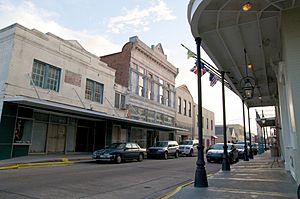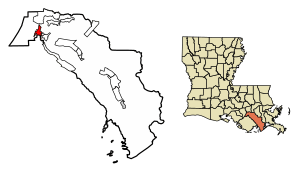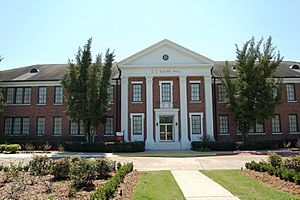Thibodaux, Louisiana facts for kids
Quick facts for kids
Thibodaux, Louisiana
|
|
|---|---|

Downtown
|
|
| Nickname(s):
Queen City of Lafourche
|
|

Location of Thibodaux in Lafourche Parish, Louisiana.
|
|
| Country | |
| State | |
| Parish | Lafourche |
| Incorporated | 1830 |
| Named for | Henry S. Thibodaux |
| Area | |
| • City | 6.79 sq mi (17.59 km2) |
| • Land | 6.79 sq mi (17.59 km2) |
| • Water | 0.00 sq mi (0.00 km2) |
| Elevation | 13 ft (4 m) |
| Population
(2020)
|
|
| • City | 15,948 |
| • Density | 2,348.06/sq mi (906.58/km2) |
| • Metro | 208,178 |
| Time zone | UTC−6 (CST) |
| • Summer (DST) | UTC−5 (CDT) |
| ZIP Codes |
70301–70302, 70310
|
| Area code(s) | 985 |
| FIPS code | 22-75425 |
| Website | ci.thibodaux.la.us |
Thibodaux (pronounced TIB-ə-doh) is a city in Lafourche Parish, Louisiana, United States. It is the main city of the parish and is located along the Bayou Lafourche. In 2020, about 15,948 people lived there. Thibodaux is also part of the larger Houma–Bayou Cane–Thibodaux metropolitan area.
The city is often called the "Queen City of Lafourche." It is also home to Nicholls State University, a well-known college.
Contents
Exploring Thibodaux's Past
The first European settlers in this area were French. They arrived in the 1700s when this land was part of French Louisiana. These settlers brought enslaved people from Africa to work on large sugar cane farms called plantations.
How Thibodaux Got Its Name
In 1830, the area became an official town and was named Thibodauxville. This name honored Henry S. Thibodaux, a local plantation owner. He gave the land for the town center and was even the acting governor of Louisiana for a short time in 1824. The town grew as a trading hub for the sugar cane farms.
The town's name changed to Thibodeaux in 1838. Then, in 1918, the spelling was officially changed to its current form, Thibodaux.
In 1896, Thibodaux was one of the first places in the United States to start rural free delivery of mail. This meant mail was delivered directly to people's homes in the countryside.
Thibodaux During the Civil War
In October 1862, during the American Civil War, the Union Army took control of Thibodaux. Before the Confederate soldiers left, they burned down buildings, bridges, and supplies they couldn't take with them.
When the Union Army was in control, they ordered that enslaved people be freed and paid for their work. This was a big change for the plantation owners in Thibodaux.
The 1887 Sugar Cane Strike
In the late 1800s, after the Civil War, sugar cane workers faced difficult conditions. Many workers, including both Black and white laborers, joined a group called the Knights of Labor. They wanted better pay and fairer treatment.
In November 1887, about 10,000 sugar cane workers went on strike. This happened during the "rolling period," which is a very important time for harvesting sugar cane. The plantation owners were worried about losing their entire crops.
The governor sent the State militia to protect people who were not striking. They also forced Black workers off the plantations. Sadly, this strike led to a very tragic event known as the "Thibodaux massacre." On November 22, 1887, armed groups attacked Black workers and their families who had sought safety in Thibodaux. Many people were killed or injured. After this, the strike ended, and it became very difficult for sugar cane workers to organize for their rights for many years.
Where Thibodaux Is Located
Thibodaux is located at 29.7922 degrees North latitude and 90.8200 degrees West longitude. The city is about 13 feet (4 meters) above sea level.
The United States Census Bureau says that Thibodaux covers a total area of about 5.47 square miles (14.17 square kilometers), and all of it is land.
People Living in Thibodaux
| Historical population | |||
|---|---|---|---|
| Census | Pop. | %± | |
| 1850 | 1,242 | — | |
| 1860 | 1,380 | 11.1% | |
| 1870 | 1,922 | 39.3% | |
| 1880 | 1,515 | −21.2% | |
| 1890 | 2,078 | 37.2% | |
| 1900 | 3,253 | 56.5% | |
| 1910 | 3,824 | 17.6% | |
| 1920 | 3,526 | −7.8% | |
| 1930 | 4,442 | 26.0% | |
| 1940 | 5,851 | 31.7% | |
| 1950 | 7,730 | 32.1% | |
| 1960 | 13,403 | 73.4% | |
| 1970 | 15,028 | 12.1% | |
| 1980 | 15,810 | 5.2% | |
| 1990 | 14,035 | −11.2% | |
| 2000 | 14,431 | 2.8% | |
| 2010 | 14,566 | 0.9% | |
| 2020 | 15,948 | 9.5% | |
| U.S. Decennial Census | |||

As of the 2020 United States census, Thibodaux had 15,948 residents. There were 5,548 households and 2,965 families living in the city.
Here's a look at the different groups of people living in Thibodaux in 2020:
| Race | Number | Percentage |
|---|---|---|
| White (not Hispanic) | 8,580 | 53.8% |
| Black or African American (not Hispanic) | 6,057 | 37.98% |
| Native American | 87 | 0.55% |
| Asian | 116 | 0.73% |
| Pacific Islander | 5 | 0.03% |
| Other/Mixed | 364 | 2.28% |
| Hispanic or Latino | 739 | 4.63% |
Arts, Culture, and History
The Roman Catholic patron saints of Thibodaux are Saint Valérie and her husband, Saint Vitalis of Milan. They were early Christian martyrs. A special container holding an arm bone of Saint Valérie was brought to Thibodaux in 1868. It is now displayed in her shrine at St. Joseph Co-Cathedral. People in Thibodaux have traditionally prayed to Saint Valérie to protect the city from hurricanes.
Several famous people are buried in Thibodaux:
- Richard D'Alton Williams, an Irish poet and doctor from the 1800s.
- Eddie "Guitar Slim" Jones, a well-known blues musician.
- Francis T. Nicholls, who served as the governor of Louisiana two times.
Learning and Education
Students in Thibodaux attend schools that are part of the Lafourche Parish Public Schools system.
Elementary Schools
- C. M. Washington Elementary School
- Thibodaux Elementary School
- W.S. Lafargue Elementary School
Middle Schools
- East Thibodaux Middle School
- West Thibodaux Middle School
- Sixth Ward Middle School
High Schools
- Thibodaux High School
- From 1950 to 1968, C.M. Washington High School was the public school for African American students in Thibodaux during a time of segregation.
Catholic Schools
The Roman Catholic Diocese of Houma–Thibodaux operates these schools:
- Edward Douglas White Catholic High School
- St. Genevieve Catholic Elementary
- St. Joseph Catholic Elementary
Colleges and Universities
- Nicholls State University
- Lafourche Parish is also served by Fletcher Technical Community College.
Local News and Internet
The local newspaper in Thibodaux is The Daily Comet. It started in 1889 as Lafourche Comet.
Cable television and Internet services in Thibodaux are provided by companies like Reserve Telecommunications, AT&T, and Charter Spectrum.
Famous People from Thibodaux
Many notable individuals have connections to Thibodaux:
- Eric Andolsek, a professional football player.
- Rezin Bowie, a Louisiana politician and inventor.
- Braxton Bragg, a Confederate general.
- Kody Chamberlain, a comic book writer and artist.
- Mark Davis, a professional basketball player.
- Mary Gauthier, a folk singer-songwriter.
- Jarvis Green, a football player for the Denver Broncos.
- Walter Guion, a U.S. senator.
- Oliver Marcelle, a baseball player.
- Graham Patrick Martin, an actor.
- Jordan Mills, a football player.
- Francis T. Nicholls, a Confederate general and former governor of Louisiana.
- Greg Robinson, an offensive lineman in football.
- Billy Tauzin, a former congressman.
- Edward Douglass White, Jr., who became the Chief Justice of the United States Supreme Court.
- Edward Douglass White, Sr., a former governor of Louisiana.
Images for kids
See also
 In Spanish: Thibodaux para niños
In Spanish: Thibodaux para niños







